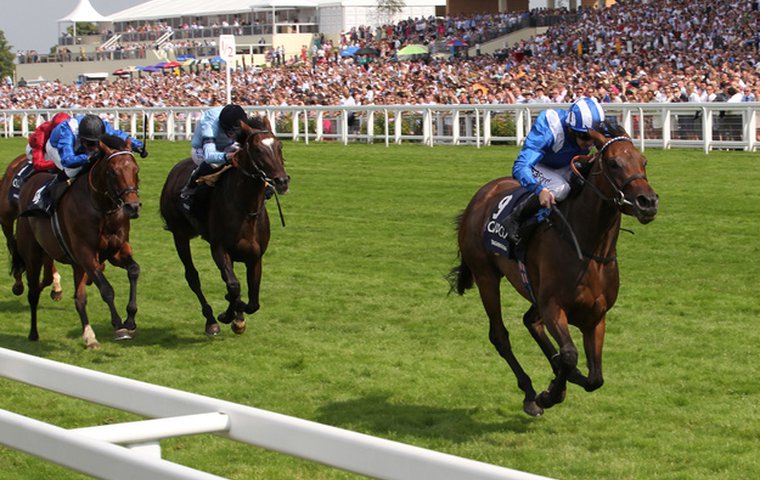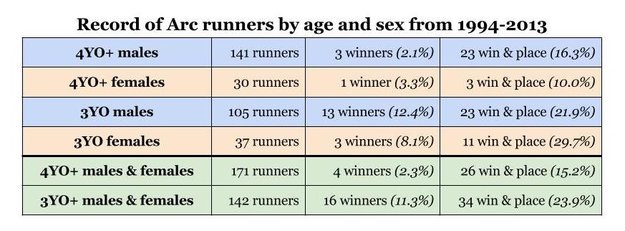
All of Europe (in racing at least) is talking about Taghrooda, winner of Britain’s most prestigious all-aged middle distance race on Saturday and now favourite to win the Prix de l’Arc de Triomphe at Longchamp in October. But how much of her current status is down to the possibly favourable weight-for-age allowance she gets as a 3-year-old filly? James Willoughby investigates.
One of the joys of the modern era of horse racing is the freedom to watch replays of a great horse many times over. One of the frustrations is that replays are soon all we have.
Taghrooda, the impressive winner of Ascot’s £1 million ($1.7 million) G1 King George VI And Queen Elizabeth Stakes, is to have just two more races before she retires to the breeding shed. So, Sheikh Hamdan Al Maktoum’s 3-year-old filly will disappear from public view just as many are getting to know her.
It is happening again. In 2008, the Aga Khan retired another brilliant 3-year-old filly, Zarkava, after her stunning victory in the Arc. And to what end? The filly she produced at stud the following year, when she could instead have been electrifying European racing fans, named Zerkeva, has never run.
Okay, you might say, what about the other side of the coin? Last year’s brilliant Arc heroine Treve has lost both her starts as a 4-year–old and a good deal of lustre with them. Doesn’t this give another side to the argument? But, even if Treve has lost the opportunity to produce an extra foal, it is still highly unlikely the offspring would ever replicate anything approaching its mother’s lost season.
When Zarkava was retired, her owner issued a statement that included the following reasoning: “The quality and youth of our broodmare band is of the utmost importance to ensure we remain breeders of racehorses capable of performing at the top level.”
But it’s only one potential foal – sometimes, sadly, not even a live foal – that is the cost. Retiring a colt can be seen to have a much more understandable commercial imperative than retiring a filly, for in this case, a breeder is sometimes conceding 200 covering fees, let alone shuttling opportunities, at a time when the potential stallion’s exploits are fresh in the memory.
Owner-breeders such as the Aga Khan and Hamdan Al Maktoum are entitled to exercise their own ambitions, however, and both have kept many female horses around longer, of course. But, rather than questioning the motivations of powerful humans, it may be more useful to look at the root-cause of the problem: weight-for-age.
If 3-year-olds were not able to receive weight concessions from older horses, they would find it much more difficult to win – and therefore would be much less likely to contest – the most prestigious all-aged races. So they would be kept around until they were mature enough to compete on level terms. This, however, would be an extreme measure to impose – and certainly will not be imposed – because weight-for-age is an established component of flat racing. All-aged races are harder to win than those restricted to older horses simply because they are open to more good horses.
But reducing weight-for-age allowances marginally is certainly an option. There is no physical law stating that 3-year-olds should receive 12 pounds from older horses over a mile and a half in late July. It isn’t the result of Newtonian physics but merely guesswork, first by Admiral Rous in the 19th century and, since then, only minor revisions to the scale have been made.
When news of Taghrooda’s success was broadcast around the racing world, an important detail of it figured in very few reports – that she was carrying 15 pounds less than the two older horses who chased her home, made up of a 3 pounds sex allowance and a 12 pounds weight-for-age allowance. According to the conventions of racing maths, 15 pounds in races over a mile and a half translates to an eight-length “start,” yet Taghrooda scored by only three.
Is this fair? Well, it depends on your definition of the word. Weight-for-age is accepted as a concept around the word, but the weight-for-age allowance itself varies. Countries such as Australia and South Africa employ a similar scale of compensation to Britain – allowing for horses being bred to Southern Hemisphere time and carrying kilograms not pounds. The U.S. scale allows immature horses slightly less.
One of U.S. racing’s most notable weight-for-age races is the G1 Jockey Club Gold Cup over a mile and a quarter at Belmont Park at the end of September. In 2007, for instance, 3-year-old Curlin beat 4-year-old Lawyer Ron while receiving 4 pounds to compensate him for immaturity. In Britain, the same type of race would have seen Curlin receive 2 pounds more.
The reports of Taghrooda’s success did feature the fact that she was the first 3-year-old filly to win the King George since Pawneese in 1976. This gap of 38 years is indicative of the scarcity and quality of King George contenders of her age and sex, rather than the task they face, however.
In the Arc – which takes place roughly 10 weeks after the King George – 3-year-old fillies now receive 11 pounds from older males, rather than 15 pounds. And they have won three of the last six renewals, despite proportionately less representation, including an exacta in 2011 when German-trained Danedream led home French-trained Shareta.
Moreover - and this should be the troubling thing for those whose defence of weight-for-age extends to nothing more than the truism “it has stood the test of time” – 3-year-olds of either sex have won 16 of the last 20 Arcs. The statistics included below show that, over these last 20 years, the younger generation has a win strike-rate nearly five times better than older horses.
For the mathematically inclined - given 3-year-olds represent just 45.4 percent of Arc runners since 1994 - binomial expansion can be used to prove that the chance of observing a result as extreme as 16 of the 20 winners is 500-to-1! In other words, the age of a horse is a statistically significant predictor of its chance in the Arc.
If the charge that 3-year-olds have an advantage were properly interrogated, the sport’s only defence would be that the above result is the result of the “survivorship bias” – that 3-year-olds who run in the Arc are, on average, better than the older horses, i.e. the best horses don’t “survive” in the sample to the age of 4.
Can you see the irony, if this is true? It’s the weight-for-age allowance that buys them the passage to stud in the first place.
In my view, the advantage enjoyed by 3-year-olds is the outturn of the breed becoming more precocious as the result of the following circular effect.
The extensive weight-for-age allowance in top races promotes the claims of more precocious 3-year-olds because some part of their superiority is being more mature at that point in their development than average. So, it is logical over time that the breed should become more precocious by horse racing’s version of the Darwinian effect – attributes associated with precocity have a disproportionately good chance of surviving in the gene pool. (This trend is also fuelled by the selection of stallions who never even faced older horses in their racing career, but were more precocious than their contemporaries in races either as 2-year-olds or in the early part of their 3-year-old seasons.)
Taghrooda herself must have a tremendous chance of becoming the fourth 3-year-old filly to win the Arc in seven years, because she is an outstanding runner – especially considering her age and sex. Darwin would be keen to have a very large wager on her, if he were still around, and I certainly am.
But she won’t be going back to Longchamp in 2015 with eight pounds more to carry. She’ll be one-and-done in the Arc and we will have only the memory - and the video - to replay.



